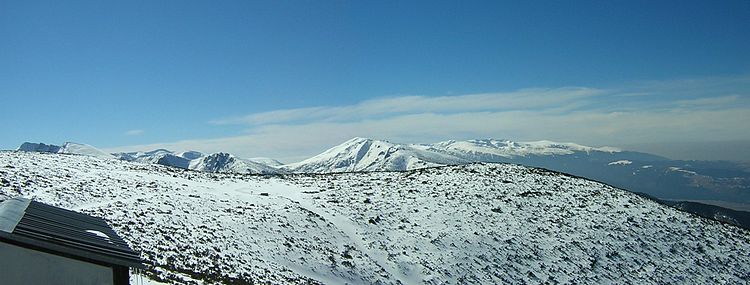


















 Rila
Rila

Rila (Bulgarian: Рила, pronounced [ˈrilə]) is a mountain range in southwestern Bulgaria and the highest mountain range of Bulgaria and the Balkans, with its highest peak being Musala at 2,925 m. The massif is also the sixth highest mountain in Europe (when each mountain is represented by its highest peak only), coming after the Caucasus, the Alps, Sierra Nevada, the Pyrenees and Mount Etna, and the highest between the Alps and the Caucasus. The larger part of the mountain is occupied by the Rila National Park.
The name Rila is believed to be of Thracian origin and is thought to mean "well-watered mountain", owing to Rila's abundance of glacial lakes (about 200) and hot springs in fault areas at the base of the mountain. Some of the Balkans' longest and deepest rivers originate from Rila, including the Maritsa, the Iskar and the Mesta.
Culturally, Rila is famous for the Rila Monastery, Bulgaria's largest and most important monastery founded in the 10th century by Saint John of Rila.
Contents[hide]
[edit] GeologyRila is a dome-shaped horst mountain, part of the Balkans' oldest land, the Macedono-Thracian Massif. It was formed by granite and gneiss rocks and crystal schists during the Paleozoic (250,000,000 years ago). Rila's alpine relief was formed during the Pleistocene by a series of glacial periods. During the most recent, so-called Würm glaciation, 10-12,000 years ago the permanent snow line was at 2,100 m above sea level. Above this line glaciers radically changed the existing relief, carving out deep cirques, sharp pyramid-shaped peaks, rock pinnacles, various valleys, moraines and other typical glacial formations. [edit] Borders and climateRila has an area of 2,400 km². The dome of the mountain rises over the surrounding mountain valleys, with the Borovets Saddle (1,305 m) connecting the main Musala Ridge with the Shipchan and Shumnitsa ridges that connect to the Ihtiman Sredna Gora mountains through the Gate of Trajan pass. The Yundola Saddle (1,375 m) and the Abraham Saddle (1,295 m) link Rila with the Rhodopes to the east, while the connection with Pirin is the Predel Saddle (1,140 m), the one with Verila being the Klisura Saddle (1,025 m). The climate is typically alpine, with 2,000 mm of precipitation on Musala yearly, about half of which is snow. The lowest average temperature ever measured in February on Musala is –11.6 °C and the absolute minimum is -31.2 °C. An average temperature for August is 5.4 °C, the maximum being 18.7 °C. [edit] Flora & FaunaThe flora of Rila contains three local endemics which are seen only in this mountain. These plants are Primula deorum (with the largest population), Rheum rhaponticum and Alchemilla pawlowskii. In the mountain thrives also 36 plants as Campanula lanata, Centaurea mannagettae which are endemic for the Balkans. Some of the plant species have survived the last glacial period by turning into relict organisms. There is also many similar animals. Some of the members of this kingdom which lives in Rila are in danger. Such animals are Barbus cyclolepis (which is rare because of the habitat loss and the river pollution), Triturus alpestris, Spermophilus citellus (European Ground Squirrel) and others. [edit] List of mammals in National park RilaThere are 48 mammal species in National park Rila Insectivores • Shrew Bats • Bats Lagomorphs Rodents • Vole Carnivores • Red fox • Marten • Wild cat Even-toed ungulates • Roe deer • Red deer [edit] Subdivision
The Seven Rila Lakes 
The source of the Maritsa under Marishki vrah 
The Rila Monastery Rila is subdivided into several parts depending on their geographic position. [edit] Peaks in Rila[edit] HonourRila Point on Livingston Island in the South Shetland Islands, Antarctica is named after Rila Mountain. [edit] Panoramic views |









